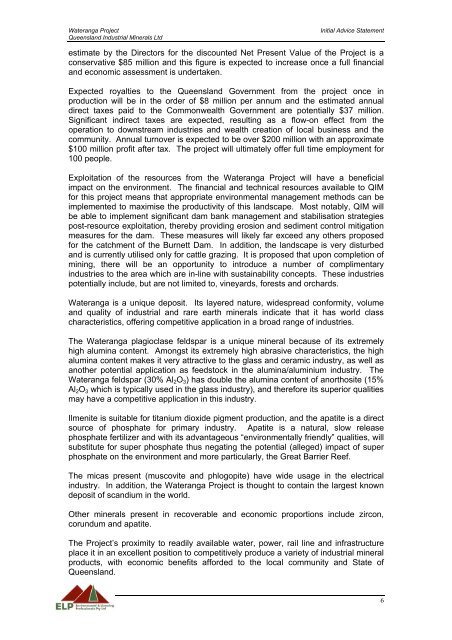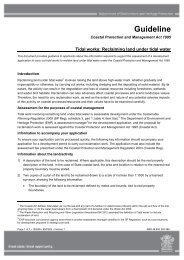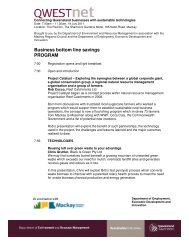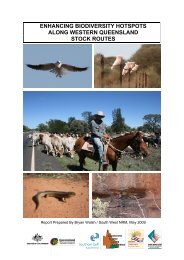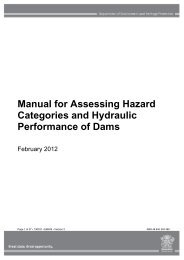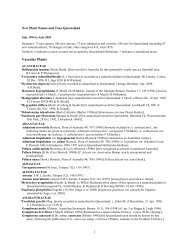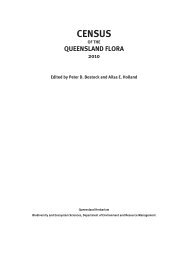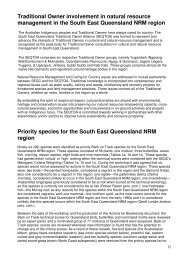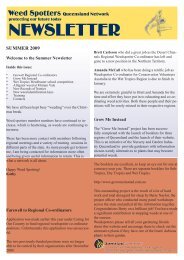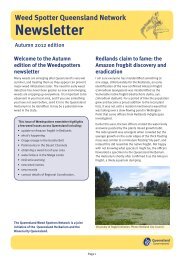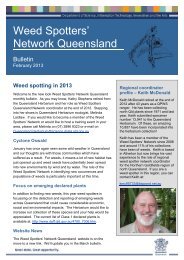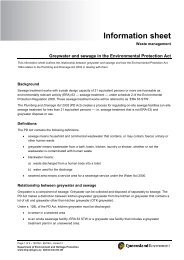WATERANGA PROJECT - Department of Environment and Heritage ...
WATERANGA PROJECT - Department of Environment and Heritage ...
WATERANGA PROJECT - Department of Environment and Heritage ...
Create successful ePaper yourself
Turn your PDF publications into a flip-book with our unique Google optimized e-Paper software.
Wateranga Project Initial Advice Statement<br />
Queensl<strong>and</strong> Industrial Minerals Ltd<br />
estimate by the Directors for the discounted Net Present Value <strong>of</strong> the Project is a<br />
conservative $85 million <strong>and</strong> this figure is expected to increase once a full financial<br />
<strong>and</strong> economic assessment is undertaken.<br />
Expected royalties to the Queensl<strong>and</strong> Government from the project once in<br />
production will be in the order <strong>of</strong> $8 million per annum <strong>and</strong> the estimated annual<br />
direct taxes paid to the Commonwealth Government are potentially $37 million.<br />
Significant indirect taxes are expected, resulting as a flow-on effect from the<br />
operation to downstream industries <strong>and</strong> wealth creation <strong>of</strong> local business <strong>and</strong> the<br />
community. Annual turnover is expected to be over $200 million with an approximate<br />
$100 million pr<strong>of</strong>it after tax. The project will ultimately <strong>of</strong>fer full time employment for<br />
100 people.<br />
Exploitation <strong>of</strong> the resources from the Wateranga Project will have a beneficial<br />
impact on the environment. The financial <strong>and</strong> technical resources available to QIM<br />
for this project means that appropriate environmental management methods can be<br />
implemented to maximise the productivity <strong>of</strong> this l<strong>and</strong>scape. Most notably, QIM will<br />
be able to implement significant dam bank management <strong>and</strong> stabilisation strategies<br />
post-resource exploitation, thereby providing erosion <strong>and</strong> sediment control mitigation<br />
measures for the dam. These measures will likely far exceed any others proposed<br />
for the catchment <strong>of</strong> the Burnett Dam. In addition, the l<strong>and</strong>scape is very disturbed<br />
<strong>and</strong> is currently utilised only for cattle grazing. It is proposed that upon completion <strong>of</strong><br />
mining, there will be an opportunity to introduce a number <strong>of</strong> complimentary<br />
industries to the area which are in-line with sustainability concepts. These industries<br />
potentially include, but are not limited to, vineyards, forests <strong>and</strong> orchards.<br />
Wateranga is a unique deposit. Its layered nature, widespread conformity, volume<br />
<strong>and</strong> quality <strong>of</strong> industrial <strong>and</strong> rare earth minerals indicate that it has world class<br />
characteristics, <strong>of</strong>fering competitive application in a broad range <strong>of</strong> industries.<br />
The Wateranga plagioclase feldspar is a unique mineral because <strong>of</strong> its extremely<br />
high alumina content. Amongst its extremely high abrasive characteristics, the high<br />
alumina content makes it very attractive to the glass <strong>and</strong> ceramic industry, as well as<br />
another potential application as feedstock in the alumina/aluminium industry. The<br />
Wateranga feldspar (30% Al2O3) has double the alumina content <strong>of</strong> anorthosite (15%<br />
Al2O3 which is typically used in the glass industry), <strong>and</strong> therefore its superior qualities<br />
may have a competitive application in this industry.<br />
Ilmenite is suitable for titanium dioxide pigment production, <strong>and</strong> the apatite is a direct<br />
source <strong>of</strong> phosphate for primary industry. Apatite is a natural, slow release<br />
phosphate fertilizer <strong>and</strong> with its advantageous “environmentally friendly” qualities, will<br />
substitute for super phosphate thus negating the potential (alleged) impact <strong>of</strong> super<br />
phosphate on the environment <strong>and</strong> more particularly, the Great Barrier Reef.<br />
The micas present (muscovite <strong>and</strong> phlogopite) have wide usage in the electrical<br />
industry. In addition, the Wateranga Project is thought to contain the largest known<br />
deposit <strong>of</strong> sc<strong>and</strong>ium in the world.<br />
Other minerals present in recoverable <strong>and</strong> economic proportions include zircon,<br />
corundum <strong>and</strong> apatite.<br />
The Project’s proximity to readily available water, power, rail line <strong>and</strong> infrastructure<br />
place it in an excellent position to competitively produce a variety <strong>of</strong> industrial mineral<br />
products, with economic benefits afforded to the local community <strong>and</strong> State <strong>of</strong><br />
Queensl<strong>and</strong>.<br />
6


